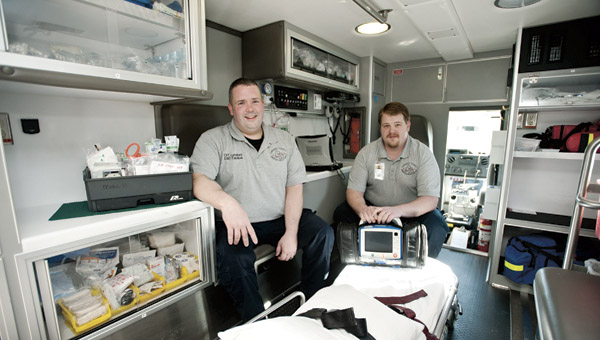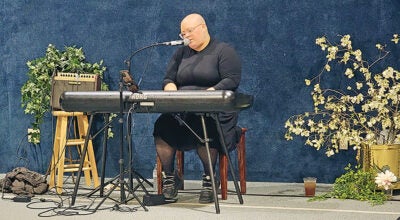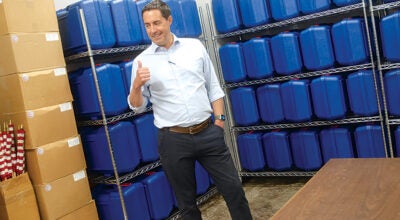PROFILE 2013: Life Savers
Published 12:26 am Sunday, March 3, 2013

Partners Pete Lunsford and David Zornes are seen inside one of the Lawrence County Emergency Medical Services ambulances.
Lawrence County’s paramedics, EMTs ready for any emergency
Pete Lunsford sits down on the sectional sofa in the living room at the Ironton EMS station to catch his breath.
Across from him the television plays that night’s edition of Jeopardy. Trivia buffs stand eagerly at their podiums, hoping to turn quick responses into cash. But the sound is low, no one at the station is really watching.
For Lunsford and his partner, David Zornes, this has been one of those days — almost non-stop runs from the time they started their shift at 9 a.m., 10 hours earlier.
As it is at so many emergency medical services, the paramedics and EMTs at the Lawrence County Emergency Medical Services work 24 hours on, then get 48 hours off.
It’s a schedule both men say they have easily adjusted to. That and the high-level energy they have to draw on instantly when the alarm sounds for the next run and the unknowns they must face.
“You get used to being on a really bad run, the chaos and the pandemonium,” Zornes said.
Then it’s over and they’re back at the station.
“It hits you and you feel like the air has been let out of the balloon,” Zornes said. “You adapt to the ups and downs.”
Each time the two men jump into one of their ambulances, they take off not knowing what they’ll see or find.
Gunshot wounds. A child dying in the backseat of a sideswiped car. A burn victim. An unmanageable drunk.
“Some we take more personally, especially abuse,” Lunsford said. “You can’t come back and eat a peanut butter sandwich.”
The Lawrence County EMS started two years ago out of necessity, when its predecessor — the Southeast Ohio Emergency Medical Services — disbanded.
However, both men, as are many of their colleagues, are veterans of the SEOEMS era, giving them almost a decade each of time in the field.
Fifteen minutes have gone by when the squawky siren that means there is an emergency call blasts through the headquarters. Zornes hooks up with the 911 dispatcher. It’s a case of afibrillation.
The men jump into the ambulance. Lunsford drives. Zornes is in the back. Arriving at their destination, Lunsford hops out of the cab to help Zornes pull the stretcher out of the back.
The patient is calm, but watches the two men intently.
Zornes puts monitors on the patient’s wrist and stomach to hook him up to a mobile EKG monitor. That will immediately give the vital information the two men, and the hospital, needs. Zornes clips another monitor on the patient’s thumb.
“I want to check your oxygen level,” he says. “Anything you want to tell me? Your pulse rate is good and regular.”
Then they’re off to the hospital with Zornes radioing in vitals to the ER.
“We’re about five minutes away,” he tells the ER nurse.
The ride is quick and uneventful. But, with the county’s new $90,000 ambulances loaded with $35,000 plus in equipment, the two men could have handled almost anything.
“Ohio puts out a standard of what you have to have on each ambulance,” Buddy Fry, county EMS director, said. “We exceed that standard. They don’t require an ambulance to have an EKG monitor. You can run an EMT service, but the patients are missing out on additional care.”
There are 25 different drugs the paramedics for Lawrence County can administer en route, from respiratory to cardiac medications. Attaching the 12 leads from the $27,000 EKG monitor can show the paramedics a true picture of the heart condition of the patient.
“It gives a picture of the heart’s rhythm.” Zornes said. “We can start heart treatment from house to hospital.”
Another piece of equipment found on these county ambulances is a CPAP or continuous positive airway pressure machine.
“That is something everybody doesn’t use, something you would get if you were in the hospital,” Fry said. “Every pre-hospital doesn’t provide this. We do care that is way beyond the standard. It is better treatment, a better outcome for the patient.
“It is what they would have to wait to get at the hospital to get started. If you want to give them medications to do a certain thing, you can do it now.
“It is faster recovery time, less chance the patient will deteriorate into something worse. If they are having a bad heart rhythm that in 10 minutes will go into cardiac arrest, maybe we will give them a drug for heart rhythm and convert it back to normal.”
Working for an EMS isn’t the typical job and it takes a special kind of person to do it, Fry says.
“You have to have an aptitude,” Fry said. “You have to be pretty tough mentally. You will see anything. This is not just a job. You don’t walk into a Walmart and stock shelves. You have to have that desire upfront. I know that sounds like a cliché, but you have to have a desire to help people.”





